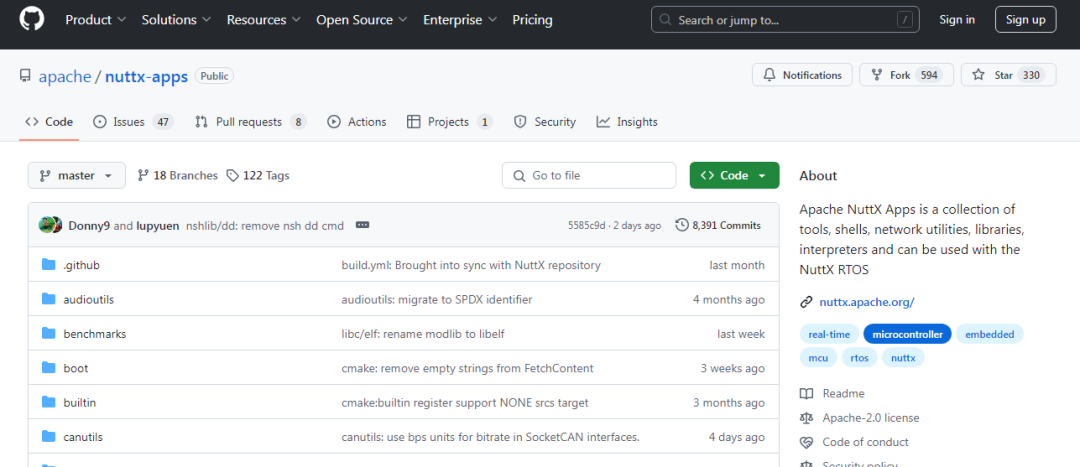NuttX is a Real-Time Operating System (RTOS), and <span>apache/nuttx-apps</span> (the actual repository should be located in the <span>apache/nuttx</span> directory under <span>apps</span>, the original link may be incorrect) provides a wealth of application examples and build tools, greatly simplifying the application development process on NuttX. Next, we will introduce the features, usage, and how to extend the functionality of <span>nuttx-apps</span>.

Application Directory Structure: Clear and Easy to Manage
<span>nuttx-apps</span> directory contains multiple subdirectories, each corresponding to an application or a group of applications. This clear directory structure makes it easy for developers to find and manage applications. Typical applications include example programs, network protocol stack components, etc. It is not part of the NuttX kernel but is provided as an independent module, allowing developers to choose to use or ignore it.
Built-in Applications and NuttShell Integration
<span>nuttx-apps</span> includes a series of built-in applications that can be conveniently called through the NuttShell (NSH) command line interface. NSH is a lightweight command line interpreter that provides basic means to interact with the system. The entry points and dependency information for built-in applications are recorded in <span>builtin/builtin_proto.h</span> and <span>builtin/builtin_list.h</span>.
By configuring <span>CONFIG_NSH_BUILTIN_APPS=y</span>, support for built-in applications in NSH can be enabled. Entering the <span>help</span> command at the NSH prompt will display all available built-in commands.
Synchronous and Asynchronous Command Execution
By default, built-in commands launched from NSH are executed asynchronously, meaning NSH does not wait for the command to complete before continuing with other operations. If synchronous execution is required, the <span>CONFIG_SCHED_WAITPID=y</span> option needs to be enabled in the NuttX configuration file. This will enable the <span>waitpid()</span> interface, allowing NSH to wait for built-in commands to complete. Of course, even with synchronous execution enabled, it is still possible to force asynchronous execution by adding the <span>&</span> symbol after the command.
Application Configuration: Flexible Configuration for Custom Applications
NuttX uses <span>kconfig</span> as a configuration tool, allowing developers to modify the NuttX configuration file (<span>.config</span>) to select which applications to compile. For example, <span>CONFIG_EXAMPLES_HELLO=y</span> will enable the <span>apps/examples/hello</span> example program. The <span>Make.defs</span> file will dynamically add applications to the build process based on the configuration options in the configuration file.
Example Application: The Best Starting Point for Learning
<span>examples/hello</span> directory provides a simple example application that demonstrates how to create a built-in application. This example shows how to write application code, create <span>Makefile</span> and <span>Kconfig</span> files, and how to add the application to the NuttX build system. Developers can refer to this example to create their own applications. It is important to note that the source code of the application must provide a <span>main()</span> function as the program entry point.
External Build and Integration: Flexible Extension Mechanism
NuttX provides various methods to handle board-specific components as well as external builds and integration of applications:
- •Export Build Results:
<span>make export</span>command can package the NuttX build results (including header files, library files, startup files, etc.) into a<span>.zip</span>file for easy use in other environments. - •Replace Application Directory: The
<span>apps</span>directory can be completely replaced with a custom application directory, and the path can be specified through the<span>CONFIG_APPS_DIR</span>configuration option. - •Create Symbolic Links: Symbolic links can be created to link external application directories to the
<span>apps</span>directory for easier management and maintenance.
Details of the Build Process: Multi-Stage Build, Efficient and Reliable
The NuttX build process is divided into multiple stages: context, depend, and default stages. In the context stage, application information is collected. This allows the build process to efficiently handle complex dependencies, ensuring that applications can be built and linked correctly.
Security Considerations: Export Restrictions on Cryptographic Software
<span>nuttx-apps</span> may contain cryptographic software, and it is essential to check the relevant laws and regulations in your country/region before use to ensure compliance with export restrictions.
Conclusion
<span>nuttx-apps</span> provides NuttX developers with a powerful application framework that simplifies the development, building, and integration processes of applications. Its clear directory structure, flexible configuration mechanism, and robust external build support make it an ideal choice for building NuttX applications.
Project Address: https://github.com/apache/nuttx-apps